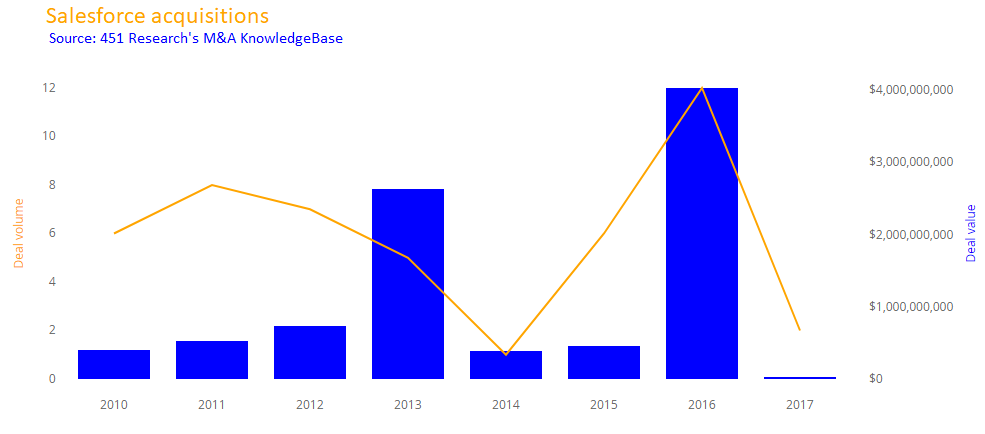Contact:Scott Denne
This week Salesforce opens up Dreamforce, its annual customer conference – and, as usual, it is sparing no expense to host tens of thousands of people in downtown San Francisco. The same can’t be said of its recent M&A efforts. The CRM giant’s last substantial acquisition – the $680m purchase of audience data management vendor Krux – printed as last year’s conference began. And although it’s been silent since, we’d expect Salesforce to resume the strategy it left off with when it begins buying again.
Leading up to last year’s show, Salesforce was coming toward the end of a record acquisition spree that, according to 451 Research’s M&A KnowledgeBase, spanned 12 deals and cost $4bn before the year was out. This year, like many of the partners, customers and investors Salesforce is hosting at Dreamforce, it’s got a bit more to digest than usual. So far, it has printed just two transactions and spent $20m of its cash on M&A (per its most recent quarterly report). Salesforce isn’t alone. Other major enterprise software vendors – IBM, Microsoft, Adobe and Oracle – have been uncharacteristically quiet this year.
When Salesforce and others emerge from their hiatus, they could have a slightly different take on SaaS dealmaking than in the past. In the first round of SaaS acquisitions early in this decade, buyers had the same strategy for software M&A that they deployed in the client server era. Back then, acquirers could leverage their strong connections in the IT department to funnel in more products. With SaaS transactions, the buyer is often the line of business, not IT, so those existing relationships don’t hold up as well.
Today, businesses from all corners are looking to leverage their data to help find new customers and cater to those they already have. For this reason, Salesforce’s chance to build out a sales channel is to expand its role in how businesses capture, segment and share data about their customers’ characteristics, behavior, preferences and history.
Salesforce has already embarked on this destination. With its pickup of Krux, it gained an asset that collects and augments data about anonymous prospects, a complement to Salesforce’s roots as a CRM firm. When Salesforce resumes buying, we expect it to hunt for additional acquisitions that would position its software as the lodestar of its customers’ data strategy.
With its legacy CRM offering, Krux and a host of artificial intelligence applications in tow, Salesforce should look to add apps that make it easier for companies to gather more intelligence about customers. One way it could go about this would be to acquire Janrain or another identity management application provider that helps businesses gather and manage data from user registrations on websites and apps. It could also consider customer loyalty application specialists such as CrowdTwist or SessionM that provide software for building out loyalty programs that entice consumers to share more of their personal data with the vendors they frequent.
For more real-time information on tech M&A, follow us on Twitter @451TechMnA.

